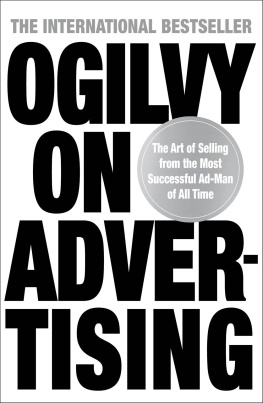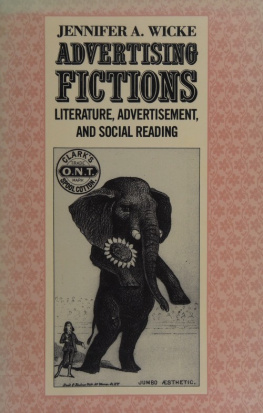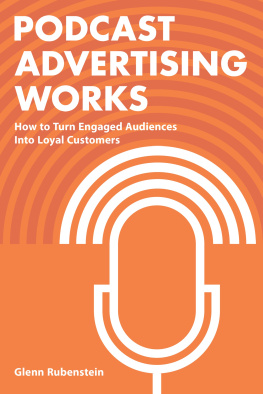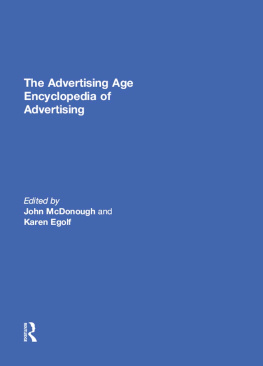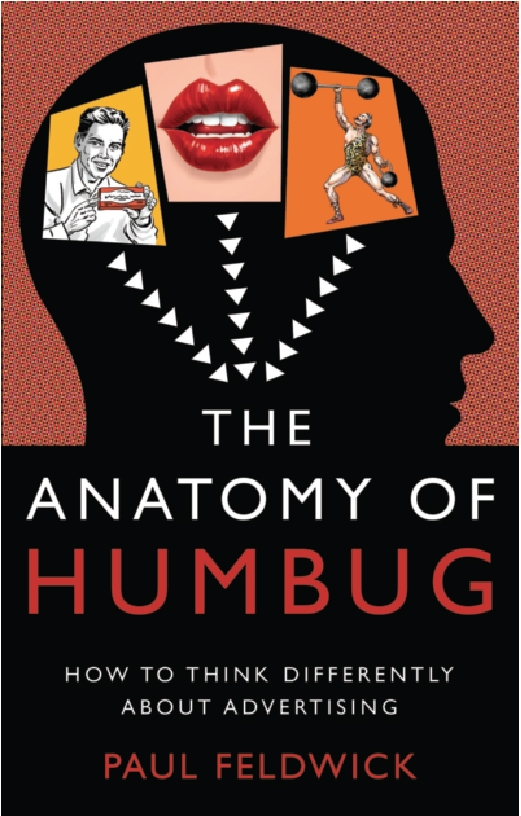The moral right of the author has been asserted.
the terms of licences issued by the Copyright Licensing Agency. Enquiries
concerning reproduction outside those terms should be sent to the publishers.
British Library Cataloguing in Publication Data.
A catalogue record for this book is available from the British Library.
Ideas we have, and do not know we have, have us.
Praise for The Anatomy of Humbug
If you think you know how advertising works, think again. This book is fascinating, provocative and inspiring. Its a joy to read.
Jim Carroll, Chairman, BBH London
The Anatomy of Humbug is an easy and enjoyable read, and the message is new, valid and useful. No-one has previously discussed the various practitioner theories of advertising so comprehensively. Its a great story, and I learned a lot.
Patrick Barwise, Emeritus Professor of Management and Marketing, London Business School.
I love this book as it does precisely what it says on the cover; not only is humbug de-constructed, but clarity shines through. Too few executives can really articulate the case for consistent advertising to their peers or shareholders, but reading this book will improve this deficit immeasurably.
Martin Glenn, CEO, United Biscuits
Paul Feldwick examines how we all think advertising works and the history of why we think that way. He, subtly, gently and wisely will make you realise that, actually, you dont really know and have just been getting on with it. Theres a lot of useful learning in this little book.
Russell Davies, Director of Strategy, Government Digital Service
A thoughtful and beautifully written reflection on the history of advertising practice. Feldwick explores how the narratives that agencies have used to sell their work still influence current beliefs about how advertising works, and offers his own perspective. Advertising practitioners that read this book may find themselves questioning tenets they have long taken for granted.
Nigel Hollis, Chief Global Analyst, Millward Brown
An elegant overview of the history of advertising theory, with the added joy of being filtered through the immense wisdom, experience and brain of this advertising guru. It shows that successful advertising is the product of rich, complex, even paradoxical approaches - which maybe explains why advertising attracts people who would be comfortable round a dinner table with both Freud and P.T.Barnum. In a world seemingly addicted to binary solutions, this book will help you avoid becoming an advertising fashion victim, to learn from the past in order to develop your own successful approach to advertising.
Tess Alps, Chair, Thinkbox
This is a genuinely original book, unlike anything ever written about advertising. Publicist P.T.Barnum, research guru Ernest Dichter, PR giant Edward Bernays, as well as advertising heroes, Bill Bernbach and David Ogilvy, are just a few of the huge cast of characters that leap off the page ... readers will be amazed at the intellectual energy, passion and eccentricity the business has excited since its earliest days. Feldwick writes with clarity and wit: his book should required reading for anyone in the business of communication.
Judie Lannon, Editor, Market Leader.
This is a unique and extraordinary book for a very simple reason: it is a dispassionate account of the advertising industry, written by an insider, which charts the often wide gulf between how we think advertising ought to work and how it really does.
Rory Sutherland, Vice Chairman, Ogilvy London.
Foreword
In Chapter Ten of this wonderfully sane book, Paul Feldwick remembers giving a lecture at an advertising seminar in Istanbul. He was presenting several case histories from the IPA Advertising Effectiveness Awards archive: the worlds most rigorously documented instances of advertising having demonstrably and unarguably delivered commercial success as measured by sales, share of market, profit and return on investment. After one such case, a leading figure in Turkish research circles raised her hand and said with absolute conviction, It is not possible that this campaign was successful. The commercial contains no consumer benefit. (No doubt she would also have insisted that bumblebees cant fly.)
Other than advertising, there cant be many activities where theory and practice diverge so widely and so frequently. Like Paul, I came into advertising knowing nothing. And though the agency I joined, J. Walter Thompson, was far more academically inclined than most (it had been dubbed the University of Advertising in the US before World War II) it offered me no immediate training. I was expected to write an advertisement before lunch on my first day and I did. The only guidance I was given, and that much later, was an introduction to what was called The Thompson T-Square. This was a set of simple questions designed to concentrate the copywriters mind on the essentials and was, as the name implied, intended as a practical tool. The questions were: What are we selling? To whom are we selling it? Where are we selling it? When are we selling it? How are we selling it?
It was, and remains, a useful checklist for anyone setting out to write an advertisement for anything in any medium and its not as simplistic as it seems at first sight. In answering What are we selling?, for example, we were encouraged to consider not just the physical product but also what that product might represent to its users. A considered answer for Parker pens, for instance, would be expected to go far beyond a prestigious writing instrument and explore the pens potential as a gift and the pleasure it could deliver to the recipient. But the T-Square was also explicitly intended to lead to the identification of The Proposition, the core of every advertisement: The Proposition is the strongest competitive promise on behalf of a product or service that can be made to the consumer in terms of his (sic) own self-interest. It must be truthful, demonstrable and unique clearly elevating the product or service over the competition. Since the T-Square dated back to the reign of Stanley Resor (who had bought the company from James Walter Thompson himself in 1916, and stayed with it until he died in 1961), this emphasis on a unique competitive consumer proposition probably pre-dated Rosser Reevess adoption of the USP on behalf of the Ted Bates agency in the late 1950s. Yet I dont remember anyone at JWT, then or later, insisting that every campaign for every client contained an explicit competitive promise. Round the world, the agency found the T-Square questions helpful because they encouraged not only a certain discipline of thought but also the exercise of open-ended speculation and imagination. But when it came to instructions about what to put into every advertisement what every advertisement should contain the Resor directive was broadly ignored. It wasnt ignored militantly or even consciously it just, collectively, must have seemed restrictive and wrong.



